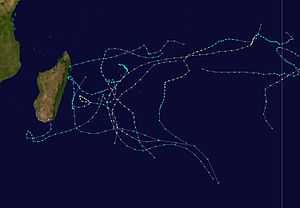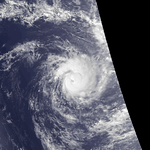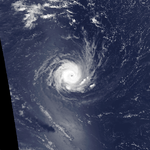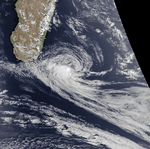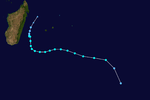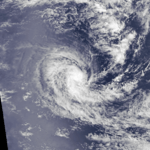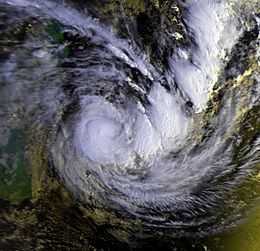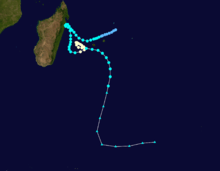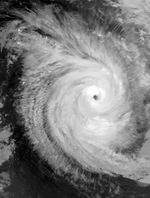1979–80 South-West Indian Ocean cyclone season
The 1979–80 South-West Indian Ocean cyclone season was a below average cyclone season. The season officially ran from November 1, 1979, to April 30, 1980.
Storms
Intense Tropical Cyclone Albine
| Intense tropical cyclone (MFR) |
| Category 3 tropical cyclone (SSHWS) |
|
|
| Duration |
25 November – 6 December |
| Peak intensity |
195 km/h (120 mph) (10-min) |
Intense Tropical Cyclone Viola-Claudette
| Intense tropical cyclone (MFR) |
| Category 3 tropical cyclone (SSHWS) |
|
|
| Duration |
10 December – 28 December |
| Peak intensity |
205 km/h (125 mph) (10-min) 930 mbar (hPa) |
Severe Tropical Storm Berenice
| Severe tropical storm (MFR) |
| Tropical storm (SSHWS) |
|
|
| Duration |
15 December – 21 December |
| Peak intensity |
95 km/h (60 mph) (10-min) |
Severe Tropical Cyclone Wilf-Danitza
| Category 3 severe tropical cyclone (Australian scale) |
| Tropical storm (SSHWS) |
|
|
| Duration |
23 December – 3 January |
| Peak intensity |
130 km/h (80 mph) (10-min) 973 mbar (hPa) |
Tropical Cyclone Hyacinthe
| Tropical cyclone (MFR) |
| Category 1 tropical cyclone (SSHWS) |
|
|
| Duration |
January 15 – January 31 |
| Peak intensity |
135 km/h (85 mph) (10-min) 955 mbar (hPa) |
Tropical Cyclone Hyacinthe was the wettest tropical cyclone on record in the world. The eighth named storm of the season, Hyacinthe formed on January 15, 1980, to the northeast of Mauritius in the southern Indian Ocean. Initially it moved to the west-southwest, and while slowly intensifying it passed north of the French overseas department of Réunion. On January 19, Météo-France estimated that the storm had intensified to a tropical cyclone. Hyacinthe looped to the south of eastern Madagascar and weakened, although it restrengthened after turning to the east. The storm executed another loop to the southwest of Réunion, passing near the island for a second and later third time. Hyacinthe became extratropical on January 29 after turning southward, dissipating two days later.
Tropical Cyclone Hyacinthe set several worldwide tropical cyclone rainfall records in Réunion in the Southwestern Indian Ocean, including a peak total of 5678 mm (223.5 inches).[1] For twelve days, Hyacinthe dropped torrential rainfall on Réunion; nearly all of the island received more than 1 m (3.3 ft) of precipitation. Over a 15 day period from January 14 to January 28, 6,083 mm (239.5 in) of rainfall were recorded at Commerson's Crater, a volcano. The heaviest rainfall occurred through a process called orographic lift in the mountainous interior, leading to hundreds of landslides. Widespread floods washed out roads and isolated three villages. Hyacinthe caused heavy damage to crops and damaged or destroyed 2,000 houses. Losses from the storm totaled $167 million (1980 USD, 676 million francs), and 25 people were killed.
Cyclone Jacinthe
| Category 3 tropical cyclone (SSHWS) |
|
|
| Duration |
February 1 – February 7 |
| Peak intensity |
185 km/h (115 mph) (1-min) |
Cyclone Fred
| Category 2 tropical cyclone (SSHWS) |
|
|
| Duration |
February 20 – February 28 |
| Peak intensity |
175 km/h (110 mph) (1-min) |
Cyclone Kolia
| Tropical storm (SSHWS) |
|
|
| Duration |
February 25 – March 13 |
| Peak intensity |
110 km/h (70 mph) (1-min) |
Cyclone Laure
| Category 3 tropical cyclone (SSHWS) |
|
|
| Duration |
March 8 – March 17 |
| Peak intensity |
185 km/h (115 mph) (1-min) |
Cyclone 22S
| Tropical storm (SSHWS) |
|
|
| Duration |
March 14 – March 20 |
| Peak intensity |
75 km/h (45 mph) (1-min) |
See also
- Atlantic hurricane seasons: 1979, 1980
- Eastern Pacific hurricane seasons: 1979, 1980
- Western Pacific typhoon seasons: 1979, 1980
- North Indian Ocean cyclone seasons: 1979, 1980
References
| 1970–1979 South-West Indian Ocean cyclone seasons |
|---|
| |
|
